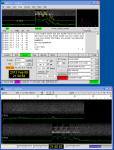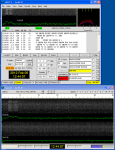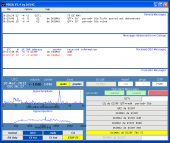The meteor scatter (MS) is one of my favorite operations on VHF.
My first HSCW (High Speed CW) MS QSO was in August 1981 during Perseides. At this time I used all home made equipment: HF receiver (21 mhz IF), transverter 144/21 MHz, 100 W power amplifier (GU-29 tube). home made programmable memory key, 600 (lpm) and tape recorder with variable speed and ring tape. And 7 elements QUAD antenna by GW4CQT.
As for a long time it was….
Somewhere in the beginning of 90-th I bough the Digital Type Recorder (DTR), constructed by DK7KF and throw out my all tape recorders. It was great: just to hear and press the button, when pings or bursts appears. A bit later we got a possibility to use computer, firstly with a software MSDSP (DOS version) than WINMSDSP-2000 (Windows version) by Tihomir, 9A4GL and finally WSJT (by Joe Taylor, K1JT), which I started to use in August 2001, mode FSK441. At the present time the most modern software for Meteor scatter is a PSK2K – the high speed meteor scatter software written by Klaus DJ5HG.
A detailed meteor shower calender can be found on International Meteor Organization site.
Short list of the major annual meteor shower with ZHR>20 is below:
| Shower | Period of activity | Maximum | ZHR | Velocity (km/sec) |
|---|---|---|---|---|
| Quadrantids | Jan 1-5 | Jan 3 | 120 | 42 |
| April Lyrid | Apr 16-25 | Apr 22 | 15 | 48 |
| E-Aquarids | Apr 19-May 12 | May 5 | 60 | 66 |
| Arietids | May 29-June 19 | June 7 | 60 | 37 |
| z-Perseids | May 20-July 7 | June 9 | 40 | 30 |
| d-Aquarids | July 12-Aug 19 | July 28 | 20 | 41 |
| Perseids | July 17-Aug 24 | Aug 12 | 100 | 60 |
| Orionids | Oct 2-Nov 11 | Oct 21 | 20 | 66 |
| Leonids | Nov 14-21 | Nov 17 | 20 | 71 |
| Gemenids | Dec 7-17 | Dec 14 | 110 | 35 |
| Ursids | Dec 17-26 | Dec 22 | >12 | 34 |
Archive of my MS logs, year-by-year.
Before 2001 2001 2002 2003 2004 2005 2006 2007 2008 2009 2010 2011 2012 2013
MS initial QSOs
50 MHz 70 MHz 144 MHz 432 MHz
Screen shoots, as a sample of some MS QSO on 6 and 2 meter bands. WSJT and PSK2K software.
Moonbounce basics
The basis of operation of Moonbounce or EME is the use of the Moon as a passive reflector. In view of the very much greater distances and the fact that the Moon’s surface is not an ideal reflector the path losses are colossal, but nevertheless it is still a form of communication that is theoretically possible to use, and one that many radio amateurs regularly use.
The Moon is around 385 000 kilometres distant from the Earth. The surface of the Moon is also reflects only about 6% of the radio signal power that reaches it. Added to the path loss for the signal travelling to and from the Moon, the overall path loss is around 251 dB on 144 MHz and 270 dB on 1296 MHz.
Might be you have read in the past that only very large stations with four antenna arrays and Kw amplifiers (and skilled CW operators) were capable of working via EME. But nowadays thanks to the JT65B digital mode, provided by the WSJT program, any station having an 2M band, SSB transceiver capable of delivering 50-100 W and a directional antenna can make successful contacts via EME. And furthermore, no CW knowledge is required! A single Yagi antenna pointing to the horizon normally allows to work EME till the Moon is up to 15 or 18 degrees above the horizon.
Some steps, you need to do, to start experiments with EME:
– Get the WSJT program from K1JT’s WEB site and install one on the computer;
– Connect the PC to the radio. Same interface, which you using for digital QSO on HF bands
– Sinchronize your PC clock to atomic standard. Dimension 4 software can be used;
– Run WSJT software and carefully setup one;
-Put attention, that your RIG running USB more and set the pass tones at 1800 HZ or more. Check also, that microphone compressor or speech processor is turned OFF.
See you on the digital segment for EME operarion! For 2M band it between 144.100 and 144.150 MHz



